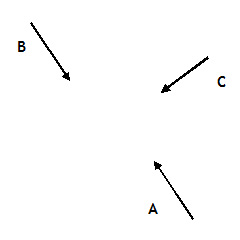
Collision Avoidance – Multiple Crossing - Collision Avoidance - Multiple Crossing
Initial Report
Report Text:
Vessel (C) Course: 225 (T) in TSS
Vessel speed: Approx. 16,5 knots
It was noted that a ferry (A) was crossing the channel at right angles to the flow of traffic. It was noted that this vessel would have a CPA of 0′ initially and that the speed of this vessel was initially approximately 16.5 knots. This vessel was on my port bow and thus I was the “stand on” vessel. Initial distance of this vessel approximately 5.5 miles
Simultaneously, it was noted that another ferry (B) was transiting in the opposite direction to (A). This vessel also had a CPA of 0′ and as she was on my starboard bow, I was obliged to keep out of her way.
Initial distance of this vessel was also approximately 5.5 miles.
The situation was monitored closely and it became apparent that the initial actions of vessel (A) were insufficient to avoid a close quarter situation with own vessel. I attempted to contact vessel (A), via VHF Channel 16. My calls elicited nil response despite my repeating the call on a number of occasions and using all methods to identify myself.
It was then noted that (A) increased her speed as a method of avoiding a close quarter situation and would pass ahead of us at a distance of approximately one mile. However, I was still having a 0′ CPA with the (B) who, quite correctly, maintained her course and speed throughout. I attempted further contact via VHF channel 16 with (A) but once again without response. I wanted to alert the O.O.W. on that vessel that his/her actions were causing me grave embarrassment with (B) and that as a result of the choice to increase speed, I was unable to alter course, as would be required, to avoid (B).
My options were now very limited as being fully laden; it was considered that a reduction of speed would have negligible effect given the proximity of the other vessels involved.
Once it was apparent that a potential `close quarter’ situation was developing, I engaged hand steering and when (A) was observed ahead of my vessel, I altered my course to starboard by an eventual 25 degrees enabling the (B) to pass ahead of me safely.
CHIRP Comment:
This incident was investigated by both the operator of Vessel (A) and the coastal state, who did not identify any significant concerns.
The narrowness of this particular waterway and the relatively high speeds of the crossing traffic can mean restrictions on the time available to assess and react to close quarters situations. The Maritime Advisory Board made the following observations:
- The passing distances involved are not unusual for this busy area and ferry bridge teams are likely to be accustomed to them, however, they should be aware that other vessels, who transit less frequently, may be concerned by their proximity and should take measures to make their intentions clear.
- Whilst VHF use may be appropriate on occasion, the time used by vessel (C) trying to establish contact by VHF may have been used more effectively in assessing and reacting to the situation. Subsequent investigations indicated (C) may not have been transmitting in any event.
- A prompt alteration of course or reduction in speed by vessel (C) may have been the best solution and would have required ferry (A) to reassess its own actions.
